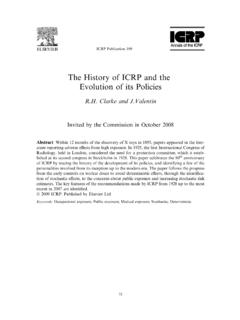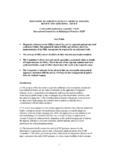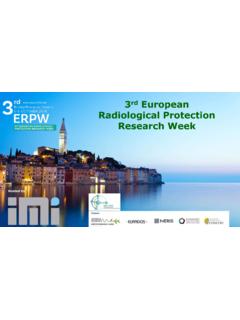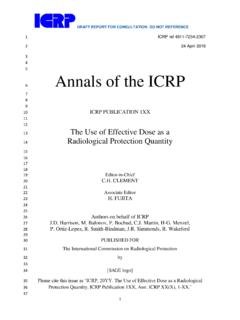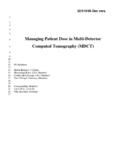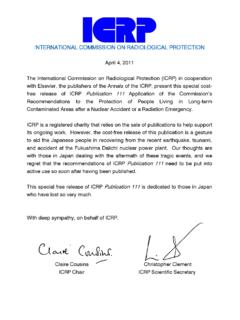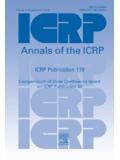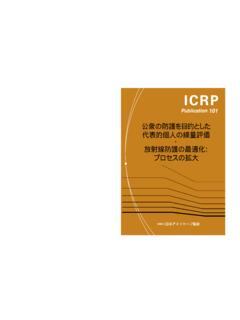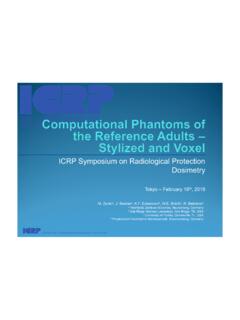Transcription of RADIATION AND YOUR PATIENT: A GUIDE FOR MEDICAL …
1 1 RADIATION AND YOUR PATIENT: A GUIDE FOR MEDICAL PRACTITIONERS A web module produced by Committee 3 of the International Commission on Radiological Protection (ICRP) What is the purpose of this document ? In the past 100 years, diagnostic radiology, nuclear medicine and RADIATION therapy have evolved from the original crude practices to advanced techniques that form an essential tool for all branches and specialties of medicine. The inherent properties of ionising RADIATION provide many benefits but also may cause potential harm. In the practice of medicine, there must be a judgement made concerning the benefit/risk ratio.
2 This requires not only knowledge of medicine but also of the RADIATION risks. This document is designed to provide basic information on RADIATION mechanisms, the dose from various MEDICAL RADIATION sources, the magnitude and type of risk, as well as answers to commonly asked questions ( RADIATION and pregnancy). As a matter of ease in reading, the text is in a question and answer format. Interventional cardiologists, radiologists, orthopaedic and vascular surgeons and others, who actually operate MEDICAL x-ray equipment or use RADIATION sources, should possess more information on proper technique and dose management than is contained here.
3 However, this text may provide a useful starting point. The most common ionising radiations used in medicine are X, gamma, beta rays and electrons. Ionising RADIATION is only one part of the electromagnetic spectrum. There are numerous other radiations ( visible light, infrared waves, high frequency and radiofrequency electromagnetic waves) that do not posses the ability to ionize atoms of the absorbing matter. The present text deals only with the use of ionising RADIATION in medicine. Is the use of ionising RADIATION in medicine beneficial to human health? Yes. Benefit to patients from MEDICAL uses of RADIATION has been established beyond doubt.
4 Modern diagnostic radiology assures faster, more precise diagnosis and enables monitoring of a large proportion of diseases. It has been estimated that in about one half of cases, radiological procedures (plain film radiography, fluoroscopy, computed tomography) have a substantial impact on the speed of diagnosis and in a large fraction of cases they are of decisive importance. Furthermore, several screening procedures (such as mammography) have been developed which are beneficial for specific populations at relatively high risk of some diseases. In addition a number of interventional radiological procedures ( angioplasty), introduced in the last 10-20 years, contribute significantly to the effectiveness of treatment of very serious and life threatening diseases of the cardiovascular, central nervous system and other organ systems.
5 These procedures are also cost-effective. Nuclear medicine uses radioactive substances, called radiopharmaceuticals, in the diagnosis and treatment of a range of diseases. These substances are especially developed to be taken up predominantly by one organ, or type of cell in the body. Following their introduction into the body for diagnostic purposes they are followed either by external measurements, yielding images of their distribution (both in space and in time), or by activity measurements in blood, urine and other media. In all cases the information obtained is of functional character.
6 This information is not obtainable, or obtainable with less accuracy, by other modalities. Nuclear medicine offers therefore unique diagnostic information in oncology (diagnosis and staging), cardiology, endocrinology, neurology, nephrology, urology and others. Most of the methods currently in use are those of choice in the diagnostic process, because they show high sensitivity, specificity and good reproducibility. Their cost-effectiveness is also high. In addition it should be emphasized that these procedures are non-invasive and present no risk of direct complications to the patient.
7 2 One has to remember that whereas electrical generators of ionising RADIATION (X-ray machines, electron accelerators) stop emitting RADIATION when switched off, radioactive sources do emit RADIATION , which cannot be modified in course of the radioactive decay. This means that some precautions may have to be taken with such patients given large therapeutic amounts of radionuclides when they are in a hospital and afterwards when they go home - to protect against exposure of the staff, relatives, friends and members of the public. RADIATION therapy uses ionising RADIATION for treatment.
8 The incidence of cancer is about 40%, reflecting long life expectancy. Cancer also leads to ~ 20-30 per cent cumulative mortality. Current MEDICAL practice uses radiotherapy in about 1/2 of newly diagnosed cancer cases. Therapeutic techniques can be highly complex, and place very high demands on the accuracy of irradiation. To be effective they must be approached on an interdisciplinary basis, requiring effective and harmonious cooperation between RADIATION oncologists, MEDICAL physicists and highly qualified technicians. However, it should be remembered that radiotherapy of cancer is often accompanied by adverse side effects of the treatment.
9 Some adverse effects are unavoidable and often resolve spontaneously or with treatment. Serious adverse effects may occur and result from the proximity of sensitive normal tissues to the treatment field or rarely as a result of individual RADIATION sensitivity. They do not undermine the purpose of radiotherapy. Appropriate use of radiotherapy saves millions of lives every year overall. Even if only palliative treatment is possible the therapy substantially reduces suffering. There are also some non-malignant diseases whose treatment by RADIATION is a method of choice. Radiotherapy using radiopharmaceuticals is generally non-invasive but limited to several well-established situations where killing hyperfunctioning or malignant cells is important (for example hyperthyroidism, cancer of the thyroid, degenerative and inflammatory diseases of joints, palliative treatment of metastases to the skeleton).
10 In addition, there are many studies showing significant potential for radio-labelled antibodies and receptor - avid peptides to be used in the treatment of several malignancies. However, this mode of treatment is still in its early days. Ionising RADIATION is, therefore, one of the basic tools of contemporary medicine, both in diagnosis and therapy. Practice of contemporary, advanced medicine, without use of ionizing RADIATION appears currently unthinkable. Are there risks to the use of ionising RADIATION in medicine? There obviously are some risks. The magnitude of risk from RADIATION is dose-related with higher amounts of RADIATION being associated with higher risks.
